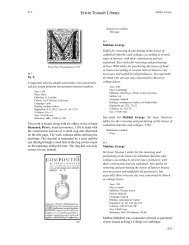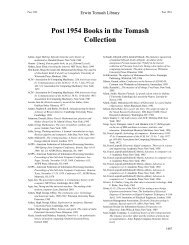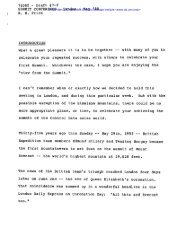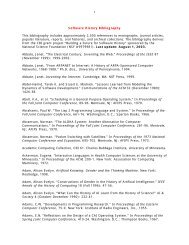B chapter.indd - Charles Babbage Institute - University of Minnesota
B chapter.indd - Charles Babbage Institute - University of Minnesota
B chapter.indd - Charles Babbage Institute - University of Minnesota
Create successful ePaper yourself
Turn your PDF publications into a flip-book with our unique Google optimized e-Paper software.
Erwin Tomash Library<br />
Bion, Nicholas Bion, Nicholas<br />
Pagination: pp. [8], 48<br />
Collation: π 4 A–F 4<br />
Size: 214x158 mm<br />
This short work is bound with the 1712 German<br />
translation <strong>of</strong> Bion. Despite the display <strong>of</strong> Bion’s name on<br />
the title page, it is written by the translator Doppelmayr<br />
and illustrates a number <strong>of</strong> instruments, which, although<br />
claiming to be from Bion’s workshop, do not appear in<br />
any <strong>of</strong> Bion’s French editions. The most inventive are<br />
optical—binocular and reflecting telescopes (some with<br />
multiple internal reflections in order to reduce the length<br />
<strong>of</strong> the tube), a camera obscura and a lantern projector.<br />
The copper engraved plates are similar in style to those<br />
used in Bion’s works.<br />
Illustrations available:<br />
Title page<br />
Telescopes and binoculars<br />
Camera obscura<br />
Lantern projector<br />
B 163<br />
Bion, Nicholas (ca.1652–1733)<br />
Telescopes and Binoculars, B 162<br />
L’ usage des astrolabes, tant universels que particuliers.<br />
Accompagné d’un traité, qui en explique la construction<br />
par des manieres simples & faciles, avec les figures<br />
necessaires pour l’intelligence de ce traité.<br />
Year: 1702<br />
Place: Paris<br />
Publisher: Chez Laurent d’Houry & Jean Boudot<br />
B 163<br />
Edition: 1st<br />
Language: French<br />
Binding: contemporary leather; spine gilt decorated<br />
Collation: a 5 A–K 12 L 2<br />
Size: 162x95 mm<br />
Reference: Bud IOS, p. 32–36<br />
Nicholas Bion was famous for books on mathematical<br />
and astronomical instruments. This comprehensive text<br />
on astrolabes is not as well known as his later, more<br />
ambitious work on the construction and use <strong>of</strong> all types<br />
<strong>of</strong> instruments. This is the last book entirely about<br />
astrolabes to be published in the French language.<br />
The planispheric astrolabe was a relatively welldocumented<br />
device when Bion wrote this treatise. It is<br />
essentially a map <strong>of</strong> the heavens superimposed on a map<br />
<strong>of</strong> the earth (or at least significant features <strong>of</strong> the earth<br />
such as the observer’s horizon, zenith, tropics, equator,<br />
etc.) with a movable rete representing the position <strong>of</strong> the<br />
stars and sun. Its major shortcoming is that it is limited<br />
to use at only one latitude. To overcome this handicap,<br />
larger astrolabes <strong>of</strong>ten were fitted with exchangeable<br />
plates for different latitudes.<br />
By the time Bion composed this work, a large number <strong>of</strong><br />
variations and modifications had been made, resulting in<br />
a so-called universal astrolabe. See the Appendix essay<br />
on the astrolabe for more information.<br />
The first <strong>chapter</strong> covers the commonly found planispheric<br />
astrolabe and describes the improvements due to Gemma<br />
151







